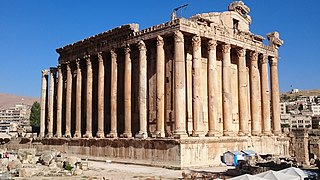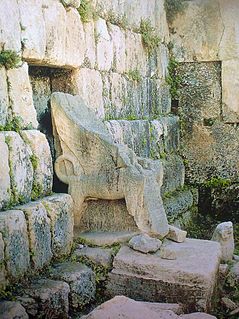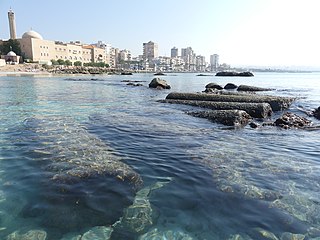 W
WAadloun, Adloun or Adlun is a coastal town in South Lebanon, 17 kilometres (11 mi) south of Sidon famous for its cultivation of watermelons. It is also the site of a Phoenician necropolis and prehistoric caves where four archaeological sites have been discovered and dated to the Stone Age. The evidence of human occupation of Abri Zumoffen has been dated as far back as 71,000 BCE with occupation of Bezez Cave dating back even further into the earlier Middle Paleolithic.
 W
WBaalbek is a city located east of the Litani River in Lebanon's Beqaa Valley, about 67 km (42 mi) northeast of Beirut. It is the capital of Baalbek-Hermel Governorate. In Greek and Roman times Baalbek was also known as Heliopolis. In 1998 Baalbek had a population of 82,608, mostly Shia Muslims, followed by Sunni Muslims and Christians.
 W
WBatroun is a coastal city in northern Lebanon and one of the oldest cities in the world. It is the capital city of Batroun District.
 W
WThe Phoenician port of Beirut, also known as the Phoenician Harbour of Beirut and archaeological site BEY039 is located between Rue Allenby and Rue Foch in Beirut, Lebanon. Studies have shown that the Bronze Age waterfront lay around 300 metres (330 yd) behind the modern port due to coastal regularisation and siltation. It was excavated and reported on by Josette Elayi and Hala Sayegh in 2000 and determined to date to the Iron Age III and Persian periods. Two nineteenth century Ottoman docks were also unearthed during construction, just to the north of this area at archaeological sites BEY018 and BEY019.
 W
WBodai is a Lebanese town in Baalbek District, Baalbek-Hermel Governorate, situated west of the Litani River in the foothills of Mount Lebanon. Bodai is located 15 km northwest of the ancient city of Baalbek and 26 km from the Lebanese–Syrian border and is 90 kilometers (55.926 mi) away from the capital of Beirut. Bodai, which sits in the foothills of the Mount Lebanon range, has views across the Beqaa Valley toward the city of Baalbek, and the Anti-Lebanon range that divides Lebanon from Syria.
 W
WByblos is a city in the Keserwan-Jbeil Governorate of Lebanon. It is believed to have been first occupied between 8800 and 7000 BC and continuously inhabited since 5000 BC, making it one of the oldest continuously inhabited cities in the world. It is a UNESCO World Heritage Site.
 W
WSarepta was a Phoenician city on the Mediterranean coast between Sidon and Tyre, also known biblically as Zarephath. It became a bishopric, which faded, and remains a double Catholic titular see.
 W
WSidon, known locally as Sayda or Saida, is the third-largest city in Lebanon. It is located in the South Governorate, of which it is the capital, on the Mediterranean coast. Tyre to the south and Lebanese capital Beirut to the north are both about 40 kilometres away. Sidon has a population of about 80,000 within city limits, while its metropolitan area has more than a quarter-million inhabitants.
 W
WThe Temple of Baalat Gebal was an important Bronze Age temple structure in the World Heritage Site of Byblos. The temple was dedicated to Ba'alat Gebal, the goddess of the city of Byblos, known later to the Greeks as Atargatis. Built in 2800 BCE, it was the largest and most important sanctuary in ancient Byblos, and is considered to be "one of the first monumental structures of the Syro-Palestinian region". Two centuries after the construction of the Temple of Baalat Gebal, the Temple of the Obelisks was built approximately 100m to the east.
 W
WThe Temple of Eshmun is an ancient place of worship dedicated to Eshmun, the Phoenician god of healing. It is located near the Awali river, 2 kilometres (1.2 mi) northeast of Sidon in southwestern Lebanon. The site was occupied from the 7th century BC to the 8th century AD, suggesting an integrated relationship with the nearby city of Sidon. Although originally constructed by Sidonian king Eshmunazar II in the Achaemenid era to celebrate the city's recovered wealth and stature, the temple complex was greatly expanded by Bodashtart, Yatan-milk and later monarchs. Because the continued expansion spanned many centuries of alternating independence and foreign hegemony, the sanctuary features a wealth of different architectural and decorative styles and influences.
 W
WThe Temple of the Obelisks, also known as the L-shaped Temple and Temple of Resheph was an important Bronze Age temple structure in the World Heritage Site of Byblos. It is considered "perhaps the most spectacular" of the ancient structures of Byblos. It is the best preserved building in the Byblos archaeological site.
 W
WTyre is a city in Lebanon, one of the oldest continually inhabited cities in the world, though in medieval times for some centuries by just a tiny population. It was one of the earliest Phoenician metropolises and the legendary birthplace of Europa, her brothers Cadmus and Phoenix, as well as Carthage's founder Dido (Elissa). The city has many ancient sites, including the Tyre Hippodrome, and was added as a whole to UNESCO's list of World Heritage Sites in 1984. The historian Ernest Renan noted that "One can call Tyre a city of ruins, built out of ruins".